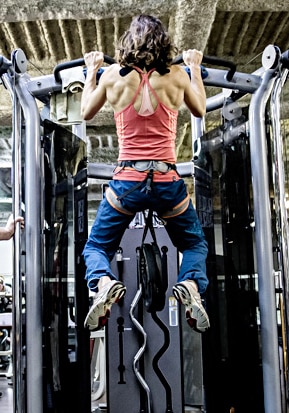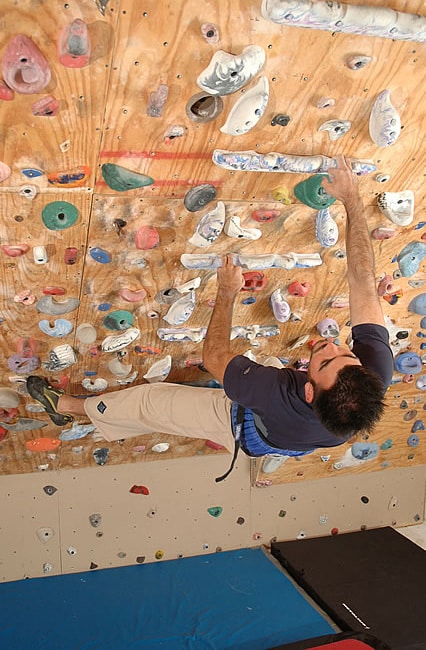
French rock star Melissa Le Neve doing weighted pull-ups. Photo courtesy of Claudia Ziegler, from her book “The Young Savages.”
Would you like to increase your pull-muscle and lock-off strength, lunging power, and pulling endurance by 20% or more? Um… Is that a trick question? Here’s how.
(This article was originally published in February of 2019.)
The formula: Commit to weighted pull-up training, three times per week, for the next ten weeks. Sound simple? It is, but only if you can commit to the process and follow through to the end.
(One caveat: If you’re plenty strong already, then this article isn’t for you! Take it up a notch with this program for one-arm pull-up strength instead.)
Test Your Pull-Up Strength
First, let’s establish a benchmark for your current pull-up endurance and strength. This will create a value for comparison when you re-test in 10 weeks. Here are the two tests:
- Endurance Metric: the number of “true” pull-ups you can do in one set. A “true” pull-up is going all the way down to straight arms and pulling up until your chin is fully above the bar (arms in lock-off position); partial pull-ups don’t count. Take this test after a complete warm-up, and use a pull-up bar or the bucket holds on a hangboard to perform the pull-ups. Record your results in a training notebook. Now, calculate where you’d be with a 20 percent increase in the number of pull-ups. This is your 10-week goal.
- Strength Metric: the maximum amount of added weight with which you can do a single true pull-up. This test requires some extra equipment—either a few weight belts and a vest (with removable weights) or, better yet, a Dips Belt or harness from which you can hang weight lifting plates (see photo). After a warm-up, begin testing yourself with a series of one-rep pull-up sets, adding weight each time until you find the maximum weight you can perform a true pull-up with. Really strong climbers can begin testing with 25% of body weight added and go up in about 10-pound increments. Most others should begin with 10% of body weight added and increase in 5 pound increments. Upon finding your max weight, record the result, and calculate your 20% goal weight.
Your 10-Week Pull-Muscle Training Program
Now it’s time to leverage a “hypergravity training” technique as detailed in my book, Training For Climbing.
In a nutshell, you’re going to simulate hypergravity (i.e. more than gravity’s natural pull) by adding weight to your body while you perform five sets of pull-ups. Ever notice how light your feet feel after taking off a pair of ski boots or a heavy backpack? We’re going to create the same effect with your climbing muscles! The key is doing all of your pull-up training with added weight (weight vest, belt, or free weights hanging from your harness). This triggers your neuromuscular system to adapt to this apparent increase in gravity. Long-term, you’ll develop a new level of strength to match this higher weight. On the rock at normal body weight, you just might feel like you’re climbing on the moon!
The “5 x 5” Weighted Pull-up Protocol
On your normal training and/or climbing days, perform five sets of five weighted pull-ups. This ideally happens during the middle part of your workout when the muscles are well-warmed but still relatively fresh. Each set will consist of just five pull-ups, followed by at least three minutes of rest. Initially, you’ll need to experiment a bit to find the right training weight—an amount that’s difficult but doable, bringing you to near-complete failure on the last rep of the fourth and fifth sets. For many people, the right training weight will settle around half of their one-rep max added weight (as identified in the Strength Metric test above). Increase your training weight as needed to stay with this protocol throughout the ten-week program.
Tip: Make sure to vary the distance between your hands slightly with each set, and do not “hang rest” in the middle of a pull-up set!
Upon the completion of this ten-week program, take two to four days off from serious training or climbing. Then perform a solid warm-up and repeat the Strength and Endurance tests. I’m confident that you’ll be pleasantly surprised with the results!
Are Weighted Pull-ups Right for You?
As a final note, weighted pull-up training is not appropriate if you cannot complete at least 10 consecutive true pull-ups. If that’s you, commit to a similar three-day-per week, ten-week program of pull-ups at bodyweight. Your training goal for each session is to perform five sets of five to eight pull-ups. The secret to your success is to have a spotter help you reach five to eight pull-ups in each of your five sets. Begin each set by doing the pull-ups with your own power. Have the spotter lift you at your hips just enough to complete five to eight reps per set. Within 10 weeks, you should become able to do 10 pull-ups on your own and feel much stronger on the rock. At that point, you can launch into the weighted pull-up protocol above.
Pro Tips on Nutrition
Over-enthusiastic training, too few rest days, and chronic protein deficiency are common contributing factors to injury for ambitious climbers. Conversely, climbers who seldom experience injuries tend to engage in high-intensity training followed by sufficient rest and low-load training while also consuming plenty of protein to support net collagen synthesis and long-term remodeling. These climbers develop stronger muscles and tendons season over season, and have a better chance of advancing their climbing abilities. Read more about how you can increase strength and lower your injury risk.
Related Articles:
- The Ultimate Guide to Hangboard Training
- Intro to Hangboard Training
- Rotator Cuff Training for Climbers
- Advanced Training for Stronger Tendons and to Promote Injury Resistance
- 4 Pull-Up Variations to Amp Up Your Workouts
Copyright © 2000–2023 Eric J. Hörst | All Rights Reserved.











